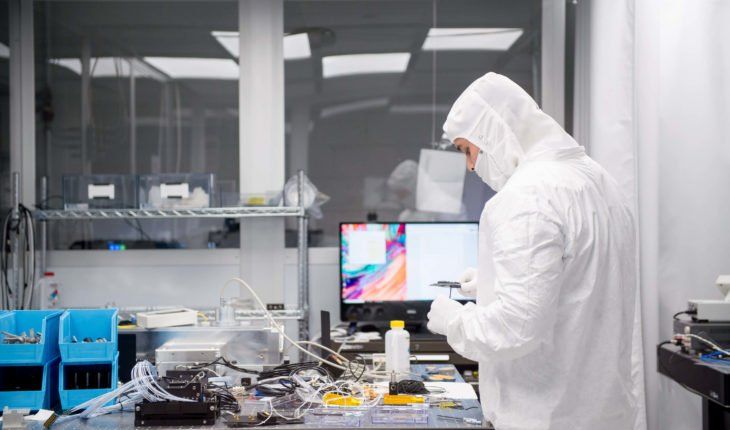Page 9639
Dec 11, 2018
IonQ Has the Most Powerful Quantum Computers With 79 Trapped Ion Qubits and 160 Stored Qubits
Posted by Klaus Baldauf in categories: computing, quantum physics
IonQ just made a presentation on two new trapped ion quantum computers with 160 stored and 79 processing qubits. This is more qubits than the best noisy superconducting quantum computers which is currently the Google 72 Qubit Bristlecone processor.
* IonQ systems are at room temperature
* IonQ manipulates ions with magnets and lasers and have software control on mostly FPGA chips.
First #selfie! I’m feeling healthy, energized and whole. This is me on #Mars. http://go.nasa.gov/2Qn6Pi6&h=AT3Q6ffKt6_9qmkSPTO3bdwJ0GlGXlT…Qbo516oeGQ
Dec 11, 2018
NASA to NBA star Steph Curry: Yes, we went to the moon, and we can prove it
Posted by Michael Lance in category: space travel
NASA has offered to give NBA superstar Steph Curry a tour of one of its lunar labs after the Golden State Warriors guard said on a podcast that he doubts humans landed on the moon.
No, really.
Curry made the head-scratching comment on an episode of the “Winging It” podcast, which posted Monday. According to Bleacher Report, Curry brought up the subject himself during the more than hour-long podcast with fellow NBA players Vince Carter, Kent Bazemore and Andre Iguodala:
Continue reading “NASA to NBA star Steph Curry: Yes, we went to the moon, and we can prove it” »
Dec 11, 2018
Best Bitcoin wallet: Hardware or hosted?
Posted by Philip Raymond in categories: bitcoin, cryptocurrencies
 All bitcoin wallets are all digital—even a paper wallet, whether a character string or a QR code. Conversely, an exchange may use “physical” wallets to host client assets, individual application wallets, or they may simply keep records of client assets that are stored, collectively, in their own master wallet. To complicate matters, Bitcoin is never really “stored” by you or an exchange service. It is stored on a public blockchain, where assets and transaction history can be traced through time by anyone. Therefore, all forms of user access are “digital”. What the reader really wants to know is “Which form of access control is better? — custodial or personal?”
Type 1: Custodial Wallets are Managed by a Trusted Party They hold your assets. You view a statement balance—just like a bank account.
All bitcoin wallets are all digital—even a paper wallet, whether a character string or a QR code. Conversely, an exchange may use “physical” wallets to host client assets, individual application wallets, or they may simply keep records of client assets that are stored, collectively, in their own master wallet. To complicate matters, Bitcoin is never really “stored” by you or an exchange service. It is stored on a public blockchain, where assets and transaction history can be traced through time by anyone. Therefore, all forms of user access are “digital”. What the reader really wants to know is “Which form of access control is better? — custodial or personal?”
Type 1: Custodial Wallets are Managed by a Trusted Party They hold your assets. You view a statement balance—just like a bank account.
Dec 11, 2018
China Launches 1st Mission to Land on the Far Side of the Moon
Posted by Alberto Lao in categories: robotics/AI, satellites
The first-ever surface mission to the far side of the moon is underway.
China’s robotic Chang’e 4 spacecraft streaked away from Earth today (Dec. 7), launching atop a Long March 3B rocket from the Xichang Satellite Launch Center at about 1:23 p.m. EST (1823 GMT; 2:23 a.m. on Dec. 8 local China time).
If all goes according to plan, Chang’e 4 will make history’s first landing on the lunar far side sometime in early January. The mission, which consists of a stationary lander and a rover, will perform a variety of science work and plant a flag for humanity in a region that remains largely unexplored to date. [China’s Chang’e 4 Moon Far Side Mission in Pictures].
Continue reading “China Launches 1st Mission to Land on the Far Side of the Moon” »
Dec 11, 2018
Wait…Maybe the Hippies Weren’t Right
Posted by Xavier Rosseel in category: neuroscience
Not surprising I suppose, and also good…to have a kind of counter article soon in the same magazine.
A recent proposal about consciousness is fascinating—but it’s not science.
- By Joshua Tan on December 11, 2018
Dec 11, 2018
These ‘useless’ quirks of evolution are actually evidence for the theory
Posted by Xavier Rosseel in category: evolution
I guess I just feel like venting for a moment… So here goes…
Why are humans the only animals with chins?
Dec 11, 2018
The Geminid meteor shower is coming to a sky near you Thursday night
Posted by Michael Lance in category: space
There’s a cool doubleheader in outer space this week: In addition to the fly-by of comet 46P/Wirtanen over the weekend, the often spectacular Geminid meteor shower will also make its annual appearance Thursday.
With hundreds of meteors streaking across the night sky, the Geminids are often the best meteor shower of the year. “The reliable Geminid shower counts as one of the year’s best, peppering the nighttime sky with 50–120 meteors per hour at its peak,” noted EarthSky.org.
More good news: The crescent moon will set around 10:30 p.m., leaving the rest of the night moon-free, Astronomy.com said. Observers under a clear dark sky can expect to see an average of two per minute.
Continue reading “The Geminid meteor shower is coming to a sky near you Thursday night” »
Dec 11, 2018
Google CEO Sundar Pichai Testifies Before Congress
Posted by Michael Lance in category: government

LIVE: Google CEO Sundar Pichai testifies before Congress on the company’s data collection practices.















